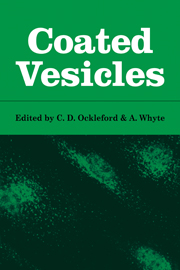Book contents
- Frontmatter
- Contents
- Preface
- Foreword
- List of contributors
- 1 Coated vesicles: a morphologically distinct subclass of endocytic vesicles
- 2 Coated vesicles in different cell types: some functional implications
- 3 Coated vesicles: their occurrence in different plant cell types
- 4 Immunoglobulin transmission in mammalian young and the involvement of coated vesicles
- 5 Coated vesicles in neurons
- 6 Coated vesicles in the oocyte
- 7 Adsorptive and passive pinocytic uptake
- 8 Coated vesicles and receptor biology
- 9 Coated secretory vesicles
- 10 Dynamic aspects of coated vesicle function
- 11 Structural aspects of coated vesicles at the molecular level
- 12 Coated vesicles in medical science
- Appendix 1 Nomenclature
- Appendix 2 References added at proof
- Author index
- Subject index
- Plate section
1 - Coated vesicles: a morphologically distinct subclass of endocytic vesicles
Published online by Cambridge University Press: 04 August 2010
- Frontmatter
- Contents
- Preface
- Foreword
- List of contributors
- 1 Coated vesicles: a morphologically distinct subclass of endocytic vesicles
- 2 Coated vesicles in different cell types: some functional implications
- 3 Coated vesicles: their occurrence in different plant cell types
- 4 Immunoglobulin transmission in mammalian young and the involvement of coated vesicles
- 5 Coated vesicles in neurons
- 6 Coated vesicles in the oocyte
- 7 Adsorptive and passive pinocytic uptake
- 8 Coated vesicles and receptor biology
- 9 Coated secretory vesicles
- 10 Dynamic aspects of coated vesicle function
- 11 Structural aspects of coated vesicles at the molecular level
- 12 Coated vesicles in medical science
- Appendix 1 Nomenclature
- Appendix 2 References added at proof
- Author index
- Subject index
- Plate section
Summary
The first workers to use the term ‘coated vesicles’ in a definitive sense appear to have been Rosenbluth & Wissig (1963, 1964), in their case to describe characteristic vesicles in toad spinal ganglia which had the ability to endocytose exogenous ferritin. Other workers have used different names to describe the same type of vesicle in a wide variety of tissues and cell types. For example, in their now classic study of yolk protein uptake by oocytes of the mosquito, Roth & Porter (1964) described them as bristle-coated. Casley-Smith (1969), in studies on macrophages, referred to them as rhopheosomes or rhopheocytic vesicles, and in so doing was following a precedent set by Policard & Bessis (1958) in what was one of the earliest studies on these vesicles. Gray (1961) referred to them as complex vesicles, Palay (1963) as alveolate, Wolfe (1965) as acanthosomes, and Maunsbach (1963) as ‘possessing an amorphous coat’. In most cases these terms refer to a distinct organised layer on the cytoplasmic aspect of the vesicle membrane which is a characteristic feature of what are now commonly known as coated vesicles. Much interest has centred on them in relation to endocytosis and it is true to say that they are ubiquitous in tissues and cells actively engaged in protein uptake. In making such a statement I do not wish to imply that protein uptake is necessarily their sole function.
- Type
- Chapter
- Information
- Coated Vesicles , pp. 1 - 24Publisher: Cambridge University PressPrint publication year: 1980
- 6
- Cited by



